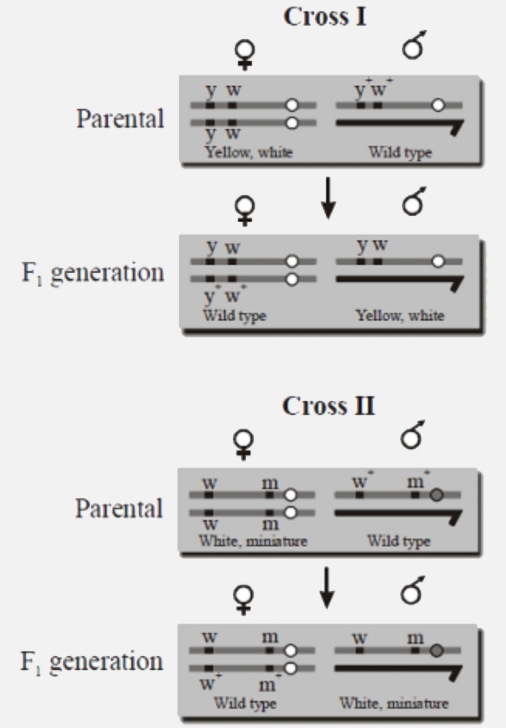The coupling and repulsion theory of Bateson and Punnett later on modified linkage and crossing over by Morgan. Two completely linked genes show a dihybrid ratio of
The correct Answer is:B
To solve the question regarding the dihybrid ratio of two completely linked genes, we can follow these steps:
Step 1: Understand the Concepts of Coupling and Repulsion
- Coupling refers to the situation where two dominant alleles are linked together (e.g., A-B).
- Repulsion refers to the situation where one dominant allele is linked with one recessive allele (e.g., A-b).
Step 2: Recognize the Implications of Complete Linkage
- When two genes are completely linked, they do not assort independently. This means that they will be inherited together as a single unit.
Step 3: Determine the Dihybrid Cross
- In a typical dihybrid cross (AaBb x AaBb), if the genes are completely linked, the gametes produced will be limited to the parental combinations (AB and ab) and will not produce recombinant types (Ab and aB).
Step 4: Analyze the Gametes
- The gametes produced from a cross of two completely linked genes (e.g., AABB x aabb) will be:
- Parental gametes: AB and ab
- The resulting offspring will be either dominant for both traits (AB) or recessive for both traits (ab).
Step 5: Determine the Phenotypic Ratio
- Since there are only two types of gametes (AB and ab), the resulting phenotypic ratio will be:
- 1 (AB) : 1 (ab)
Conclusion
- Therefore, the dihybrid ratio of two completely linked genes is 1:1.
Final Answer
- The correct answer is 1:1.
---
- Coupling refers to the situation where two dominant alleles are linked together (e.g., A-B).
- Repulsion refers to the situation where one dominant allele is linked with one recessive allele (e.g., A-b).
- When two genes are completely linked, they do not assort independently. This means that they will be inherited together as a single unit.
- In a typical dihybrid cross (AaBb x AaBb), if the genes are completely linked, the gametes produced will be limited to the parental combinations (AB and ab) and will not produce recombinant types (Ab and aB).
- The gametes produced from a cross of two completely linked genes (e.g., AABB x aabb) will be:
- Parental gametes: AB and ab
- The resulting offspring will be either dominant for both traits (AB) or recessive for both traits (ab).
- Since there are only two types of gametes (AB and ab), the resulting phenotypic ratio will be:
- 1 (AB) : 1 (ab)
- Therefore, the dihybrid ratio of two completely linked genes is 1:1.
- The correct answer is 1:1.
Topper's Solved these Questions
Similar Questions
The frequency of crossing over between any two linked genes is
View SolutionDetermination of percentage of crossing over between two linked genes is important in
View SolutionA dihybrid test cross ratio for two linked genes in a hybrid is
View SolutionA dihybrid test cross ratio for two linked genes in a hybrid is
View SolutionBateson used the terms couping and repulsion for linkage and crossing over .Name the correct paraental or coupling type slong with its cross over or repulsion :
View SolutionConsider the following statements regarding linkage
(i) The linked genes are located on the same chromosome.
(ii) Crossing over between linked genes is maximum.
(iii) The linkage can be broken by crossing over.
(iv) Linkage is against Mendel's law of segregation.
View SolutionRead the following statements and chosse the correct option. (a) Test cross for completely linked genes shows recombinanats of more than 50% (b) The type of phenotypes produces by two comletly linked genes is always greater than two
View SolutionA scientist performed the gene mapping experiments in maize. He mapped the gene on chromosomes on the basis of % crossing over between different genes. One map unit corresponds to one % crossing over or recombination. Te genes showing more than 50% recombination were not supposed to be linked on same chromosome. In crossing over studies on maize, scientist observed the following % crossing over between A B, C, d- between. A and D 10% between A and C 3% between genes C and D 7% between genes A and B 5% , and between genes C and B 8% on the basis of above observation find out the correct sequence of tenes Alt B, C, and D on chromosomes :-
View SolutionThe figure shows the experiment of T.H Morgan on the linkage. If in cross-I, genes are tightly linked and in cross-II, genes are loosely linked then what will be the percentage of recombination produced in cross-I and cross-II respectively?

View SolutionAssertion: The maximum frequency of recombination that can result from crossing over between linked genes is 50%.
Reason: Linked genes show higher frequency of crossing over if the distance between them is longer.
View Solution
